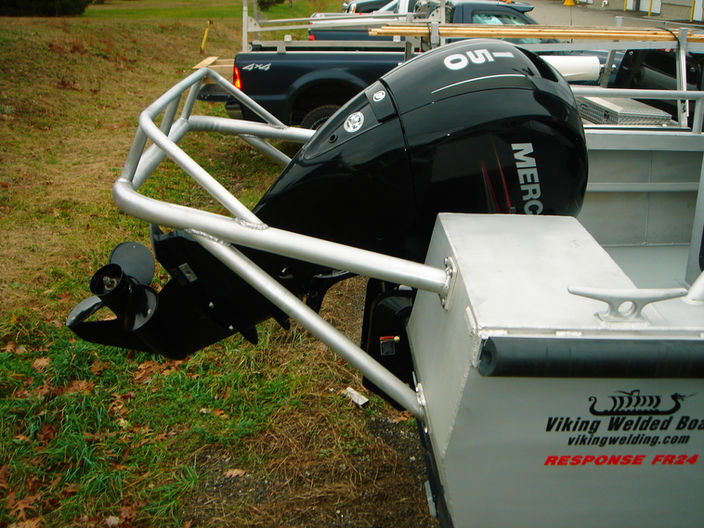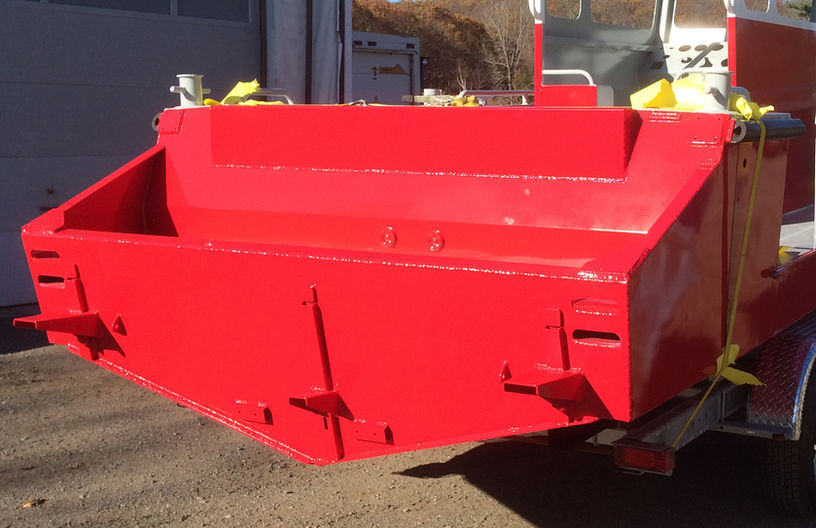Kit & Custom Design Services:
The process begins with discussions of your design goals. Depending upon these goals you may consider one of our existing kits, or an existing kit with some modifications, or an entirely new design. Determining factors will be the desired "look and feel" of the boat as well as functional considerations such as operating requirements and propulsion, and outfitting. Along the way, we will be considering weights and trim, and kit or design costs will be nailed down. Your construction logistics and experience are also important considerations.
While most of our designs have been planing hulls of various shapes, we do have experience with some more unusual applications and solutions. These include 47' x 6' canoes for construction and use in Central and South America, a 30' wood/steam powered tug, a 17' drone tug with electric drives and 8' (!) props, 35' to 50' Hickman Sea Sled derivatives, and more. Our only inviolable theme is welded aluminum construction.
In all cases we are working with 3D models and produce 2D developed parts for NC cutting files, though if requested we will also provide dimensions for hand layout and cutting.
Design Considerations:
Functional parameters will dictate a great deal of the design product. Depending upon the demands of the application, whether it is specific-purpose or versatile, work or recreation, the functional parameters will point towards specific propulsion requirements, accommodations, speed, handling and stability all of which will lead to the pursuit of a relatively narrow range of candidate hull forms and deck arrangements. Within that envelope, however, there is often a range of aesthetic considerations that may dramatically effect the look and feel of the boat and even the expense of the boat, while having perhaps only a marginal effect on function.
To pick just three such aesthetic details that have a major influence on the look and feel, please consider the following glimpses of sheerline, stem treatment and transom treatment. Any variants of these, as well as other shapes may be incorporated in a design- in many cases even as an easy modification to an existing kit.
Sheerlines:
Stem Treatments:
Our stem sections (above the chine) tend to be of four different types depending upon customer preference and the use of the boat:
1. Sharp
For the sharp stem the topside plates terminate at the forward edge of the keelson/stem. Depending upon the joint detail, the finishing is then to a slight radius blending the side plates and keelson edge. While many customers prefer this look, generally we favor the other options, which in our opinion add a dash of style.
2. Trapezoidal Flat
This has been the standard stem for Winninghoff Boats, a pioneer in northeastern US aluminum boatbuilding, since the 1980's. Tapering up to a width of roughly 4" at the deck, the appearance reminds one of the rugged stems of traditional wooden boats and thus adds a bit of character. It is relatively easy to build and provides an opportunity for finessing any misalignment of the topside plates.
3. Constant Radius
In this detail the topside plates come in tangent, or nearly so, to a pipe or rod section normally in the 2" to 3" diameter range. It provides a graceful finished look and helps to dress the transition between the terminations of the bottom, chine and topside plates. In our opinion, stylizing, or avoiding, hard corners and tight radii on a welded aluminum boat can greatly improve the look and feel of the boat, and this detail is an easy, yet very noticeable, step in that direction.
4. Bow Cone
Bow cones on boats in the 25' to 45' range tend to taper down from a starting radius in the 6 to 15" range at the deck. Of the four options, the bow cone has the greatest functional impact as it provides more deck space and fender bearing area for bow-on operations as well as increasing internal volume and flare angle at the forward sections. Additionally, when required, it integrates well with a radiused vertical knuckle for the rub rail. Our bow cones are provided as NC cut parts with a jig and lines for bumping at 2 degree increments. (At 2 degrees the bump lines are are easily buffed to invisibility.)
Transoms:
The greatest variation in transom treatments is naturally with our outboard powered boats. For these we have done everything from traditional cut-outs in radiused or flat transoms to inset wells, weld-on brackets and integral brackets. Our most common treatment, particularly with twin engines, is the full width cut-down with a false transom ahead of the well. In this installation the hull bottom and side plating continues to the engine transom, and thus engine transom is truly the transom of the boat. Their are many variants to this style, which provide a range of looks and functions.
In hybrid cases, or with true brackets, we often tweak the bouyancy of the engine area in the design stage in order to manage weights and trim. Generally, this involves adjusting the lower and outboard volumes in way of the outboard engines.
We favor radiused transoms for inboard, jet and I/O boats as it adds a bit of style and also provides a stiffer panel both during and after fabrication. In some cases we will also add a knuckle (in profile view) to these transoms for additional style or function.
Levels of Customization:
0.
Zero customization. An existing kit, as is.
1.
Minor changes to an existing kit which require no changes to the existing skins and structure. For example: Changes to transom cutouts, adding/changing a fuel tank or helm console
2.
Slightly more major surgery to an existing kit, requiring re-modeling of the transom, decks and coamings, but no changes to existing side and bottom structure.
3.
A bit more re-modelling to revise a sheerline or stem, for instance, which changes the side plating and structure.
4.
Relatively major re-modelling resulting from size changes or changes to propulsion, deck arrangement (including house changes, if applicable). Such changes will often require a detailed weight study and change in bottom shape and dimensions.
5.
An entirely new design, though one that is based on a relatively close relative of an existing kit.
6.
An entirely new design with no close relatives in our design library.


























